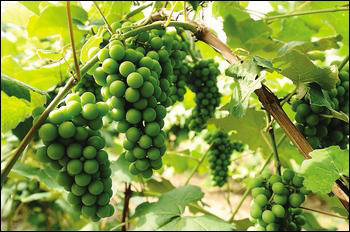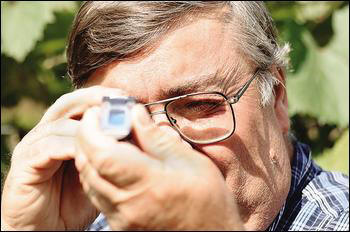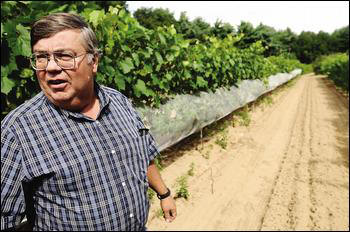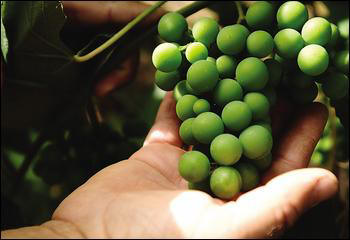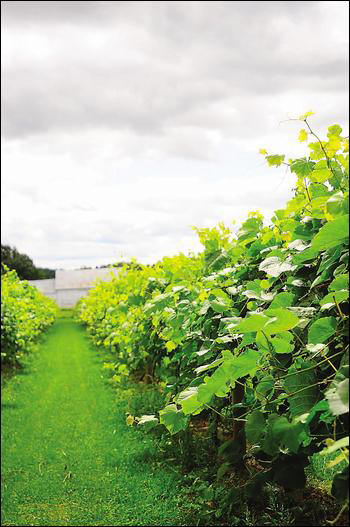 Hid-In-Pines Vineyard
Hid-In-Pines Vineyard
Best Viewed at 1280 x 1024
Press-Republican August 30,2008
WILLSBORO -- Research is helping
determine what type of grape vines can handle the chill of a
North Country winter and the region's short growing season. Richard Lamoy volunteers at the
Cold Hardy Wine Grape Cultivar Trial, which is located on
the Cornell E.V. Baker Agricultural Research Farm in
Willsboro. Lamoy attended an open house there after he
planted his own vineyard in 2005. "I saw a lot of the varieties I
had decided to try were there," he said. Some of those varieties are
borderline for this region, grown more for research
comparisons with the cold hardy grapes. There are 25
varieties of grapevines, planted in three vine blocks that
are replicated four times in random locations along 10 rows
throughout the small, fenced in plot overlooking Lake
Champlain. "Cold hardy grapes are helping
the industry (wine making) catch on in Northern New York,"
Lamoy said. Kevin Iungerman, an extension
associate with the Cornell Northeast New York Commercial
Fruit Program is the project leader. The farm has received
funding and support from that program as well as State Sen.
Elizabeth Little, the Northern New York Agricultural
Development Program, the New York Farm Viability Institute
and numerous volunteer growers. "It's not a project of the (E.V.
Baker Agricultural Research) farm," he said. "We are using
no funds from the Baker Farm project." This is the third growing
season. It takes three growing seasons before a substantial
harvest will be available. Five of the varieties at the
trial were picked for their reputed excellence in cold
winters of Wisconsin and Minnesota. Others were used for
comparison. "I expected more cold injury.
That hasn't really occurred," Iungerman said. "I expected
one-third to half to be damaged." He said recent warmer winters
may be to blame. Last year, the lowest temperature recorded
at the trial was 11 below zero Fahrenheit. Lamoy said a number of varieties
are good down to 15 below. "We figured they would die
during the winter, which would be good for the study," he
said. "But, not many have died." Two of those varieties, Cayuga
White and Niagara, are more suited to the Finger Lakes
region, Lamoy said. They have been successful here, which
has surprised some growers, he said. Iungerman hopes the trial will
help encourage a number of small vineyards in the region,
similar to what's happening in Wisconsin, Minnesota and
Iowa. "I think the potential is
there to a degree. We can have a small (wine making)
industry here," Iungerman said. "Our counterparts on the
Vermont side of the lake are ahead of us." That includes several small
commercial vineyards that are in operation, he said. Next year's proposal
includes making wine from five different varieties, but
also a study of the effects of different forms of vine
maintenance and growth patterns. Volunteers are at the trial
several times a year, for pruning, canopy control, to
put up bird netting and harvest. Iungerman usually gives
a short presentation on those and other topics at those
times. He was the one who chose the
location, which overlooks Lake Champlain. Lamoy said the
Champlain Valley works for growing grapes because
temperatures are higher than the surrounding area. There are several keys to a
successful vineyard, he said. One is to carefully select
a site. Lamoy said grapes grow best on poor soil. "Grapes, in general, like
well-drained soil," he said. If the soil is too rich, the
canopy growth can be difficult to control, Lamoy said.
It's best to properly match the variety of grape to the
soil available, he said, and it's also important to not
plant all one variety until you know what works well in
your area. Some pesticides are used at
the research plot, Lamoy said. "We want to control disease
and insect damage so we can compare the different types
better. It controls some of the unknown variables," he
said. Lamoy said many of the
grapes have reached veraison, a French term for the
point where fruit starts to change color, get softer and
increase in sugar level. Harvest usually takes place
in mid- to late-September through October. "Different varieties mature
at different times," Lamoy said. He said some nice, warm
weather from now until harvest would be best. The heat
causes sugar levels to rise and lowers the acid levels,
he said After harvest, five
varieties will be used to produce wine at Cornell, Lamoy
said. A potential vintner
should do as much research as possible, he said.
It's nice to have a resource like the cold hardy
grape trial in the area, Lamoy said. All of the cold hardy
grapes at the trial are hybrids, crossed with native
grapes that are able to survive in the cold. In cold climates, two
canes (main trunks) are often used. That way, if one
dies during the winter, the other will be available
in that spot the next growing season. There are several
methods of arranging growth, Lamoy said, each with
benefits and disadvantages. Several different types
are being used at the trial, to study which works
best with each type of grape. Frontenac grapes grow
well in northern New York. They are capable of
surviving temperatures as low as 30 degrees below
zero Fahrenheit. The grapes are used to
make a red wine. Another variety that grows well in
colder climates is Frontenac gris, which is used to
make a white wine, Lamoy said. The Frontenac varieties
and one called Marquette are well suited to the
Champlain Valley, Lamoy said. Another variety
developed in Minnesota, Le Crescent, also works
well, he said. "It makes a really nice white wine,"
Lamoy said. The right amount of sun
is important to make grapes ripen, but too much can
cause them to burn, Lamoy said. He showed a cluster
of noirette where several of the grapes had been
ruined by the sun. Lamoy operates his own
vineyard at his Hid-In Pine Farm in Morrisonville.
He first planted grapes in 1978. "It was a small
planting. There wasn't much of a selection (of grape
types) back then," he said. Lamoy gave up after a
few unproductive seasons, and waited more than 20
years to give it another go 3 years ago. He is now
experimenting with a number of cold hardy wine
grapes. His backyard vineyard
has about 750 grapevines. That includes 30 varieties
of grapes, 25 of which will be used to make wine. He also has a nursery
with about 1,200 seedlings for the future. Hybrid grapes such as
the cold-hardy varieties produce about one gallon of
wine per vine. Each gallon can fill five wine
standard-sized wine bottles. "They will produce
between a ton-and-a-half to two tons of grapes. That
will make between 150 and 200 gallons of wine," he
said. His property features fairly
sandy soil, which is good. It is surrounded by large trees,
which is not so ideal. It would be better if there was more
of a chance for the air to circulate, he said. Wine grapes often carry a much
higher sugar content than table grapes, Lamoy said.
Typically, they are ready for harvest between 20 and 26
brix, the scale used to measure sugar content. Lamoy used a refractometer to
check the sugar level of some Frontenac grapes. A few drops
of juice are squeezed onto the device, which measures the
sugar level. The juice was at about 15 brix,
and will be ready for harvest when it reaches 26. "This year we're a little ahead
on ripening. Last year the Frontenac were about 11 (brix) at
this time," Lamoy said. Lamoy has more than cold hardy
grapes. There are several vines of Chardonelle, a hybrid
grape developed from Chardonay. He said it is supposed to need a
longer growing season, but seems to be working well in his
vineyard. Lamoy said his vineyard offers a
chance to experiment and provide enjoyment and exercise. He is using a wide variety
similar to the research trial, an attempt to find out which
ones work best on his property. "When I figure out which ones
work, I will put in a bigger vineyard with a smaller
variety," Lamoy said. dheath@pressrepublican.com
Published August 30, 2008 08:15
pm - Researchers seek
suitable grapes for winter's wrath.
North Country Grapes
By DAN HEATH
Staff Writer
